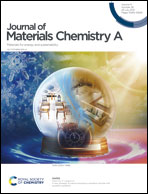Aniline-based hole transporting materials for high-performance organic solar cells with enhanced ambient stability†
Abstract
The selection of interfacial layers in organic solar cells (OSCs) is crucial for enhancing their power conversion efficiency (PCE) and operational stability. PEDOT:PSS is the most widely used hole transport layer (HTL) for high-performance OSCs; however, device stability is often severely degraded, owing to the strong acidity and hygroscopicity of PEDOT:PSS. Herein, we report a new efficient HTL system comprising an oligo(aniline) host (PBD) and an aryl sulfonic acid dopant (PFBSA), and demonstrate its use in high-performance OSC devices. Desirable properties like solvent orthogonality, high transmittance, excellent conductivity, and appropriate work function establish the suitability of the PBD:PFBSA film as an HTL. Thus, a PBD:PFBSA HTL is employed in the PM6:Y6-based OSC system to achieve a PCE of 15.24%, which is comparable to that of the PEDOT:PSS HTL-based OSC. Importantly, the PBD:PFBSA HTL-based OSC exhibits significantly higher device stability than the PEDOT:PSS HTL. We investigate the film properties of the PBD:PFBSA HTL to elucidate the origin of the superior device stability. Our results highlight the successful design of a protonic acid-doped oligo(aniline)-based material and its practical application as an effective HTL for OSCs.



 Please wait while we load your content...
Please wait while we load your content...